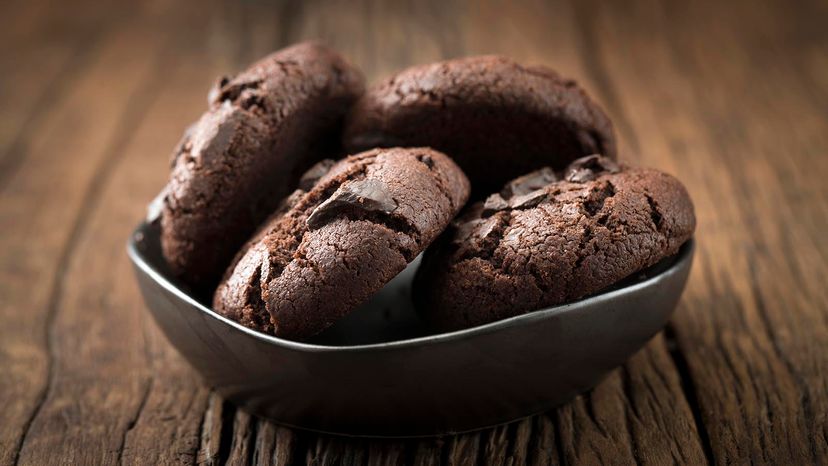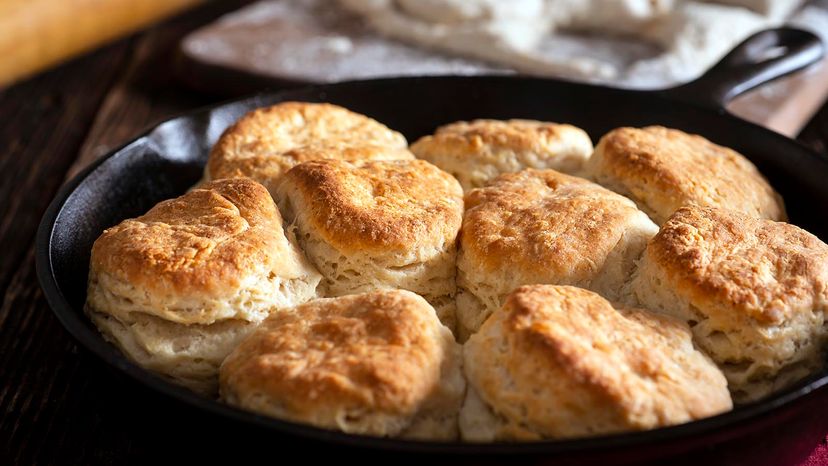By: Stephanie Vermillion

Your favorite pie crust recipe might call for butter or shortening, but are they really one in the same? Meaning, can you use butter when you're baking biscuits, cookies, pies and other recipes that call for shortening and vice versa?
Technically, yes. You can use them as a one-to-one swap, according to butter brand Land O'Lakes. But should you? Probably not — if you can avoid it. Swapping one for the other could lead to different flavors, textures or appearances — something you may be able to deal with, but it's best to thoroughly understand each fat first.
Advertisem*nt
Butter adds important fat and flavor to recipes it's used in; it contains 80 percent butterfat and about 20 percent water. Shortening, on the other hand, is all fat, no flavor. It's typically made with vegetable oils and used for its ability to help baked goods retain shape while staying soft.
So what really is the difference between butter and shortening? We talked to North Carolina cooking teacher, professional food writer and seasoned recipe developer Sheri Castle to explain the ins and outs of butter and shortening.
Contents
- Composition Differences
- Flavor Is a Key Differentiator
- Textures Also Vary
- Use Butter and Shortening Together
Composition Differences
The differences between butter and shortening vary, starting with how they're produced in the first place. Butter comes from an animal, typically cow milk, Castle says. Shortening is more closely related to margarine. It's a form of vegetable oil, often hydrogenated palm and soybean oils, and never comes from an animal. That means shortening technically is vegan.
One of the most obvious differences between butter and shortening is apparent when the fats face heat. "Butter will get soft at room temperature, but it's firm when refrigerated. It has a lower smoke point, and will burn fairly quickly in heat," Castle says. "Shortening is solid at room temperature. Butter melts, but shortening never would."
Advertisem*nt
While butter is yellow, shortening is a soft, powdery white — something Castle says manufacturers used for marketing. "It's snowy, pure and white, which gave the sense of its high quality, safety and purity," she says.

Advertisem*nt
Flavor Is a Key Differentiator
If you opt for shortening instead of butter, expect no added flavor in your recipe. Butter is inherently salty and rich, while shortening is entirely tasteless. That's why people spread butter on their bread, not shortening. It's also why cooks use butter in all sorts of dishes, while shortening is typically used only for baking.
Of course, not all butter is created equally. Salted butter is ideal for spreading on toast or using in pasta. You can use it when you don't need to fully control the amount of salt in a recipe. While it may be less salty, unsalted butter also has a nice taste. It's sweeter, mellower and closer to butter in its purest form. (That said, it does go bad more quickly as salt helps preserve salted butters.)
Advertisem*nt
Textures Also Vary
Shortening is ideal for baked goods that need to hold their shape, such as pie crusts. Since it doesn't melt at room temperature, shortening can keep the final product looking clean and feeling softer for extended periods. "Think of those fabulous cakes at the grocery store; they always use shortening [in the frosting] to hold the shape," Castle says. "Butter would get hot and run. That's why a lot of butter creams are actually shortening creams."
Castle says she often uses shortening when teaching new bakers how to make pie crusts as well. "It doesn't melt in the warm kitchen or with warm hands holding it," she says. "Shortening gives strength to the dough." The difference in a pie crust with shortening versus butter is that the former would be less flavorful than a crust made with butter.
Advertisem*nt
Cookies are another great example of butter versus shortening differences. With only shortening, cookies will retain their shape through cooking. They usually end up standing taller and feeling softer. But they also lose that rich, buttery flavor. That's why most cookies call for butter, even if this leaves them a bit flatter (since butter doesn't retain shape as well). Butter also leaves baked goods with a slightly crispier texture.
Use Butter and Shortening Together
Since butter and shortening bring something different to each recipe, it only makes sense to use them in tandem. "Butter gives you the flavor and color, while shortening gives you strength in dough," Castle says. "I made two dozen biscuits recently, and I wanted them to be thicker, so instead of one stick of butter (eight tablespoons), I used six tablespoons of butter and two tablespoons of shortening." For cookies, a mix of both could result in rich, buttery flavor with a taller, softer final product.

Advertisem*nt
Now That's Interesting
Yes, shortening is ideal for baking, but it's surprisingly a jack of all trades. Shortening can lube squeaky hinges and locks, shine headlights and even remove gum from your child's (or your own) hair.
Butter Shortening Difference FAQ
Can you substitute butter for shortening?
Technically, you can swap them one-to-one, but your baked good will ultimately have a different flavor, texture, and/or appearance if you do. If you have some, but not enough shortening, use a mix for great results.
What can you use in place of shortening?
While nothing will be a perfect substitute, you can try the following: 1. If you're OK with the recipe turning out richer, but less flakey, sub in butter or margarine. 2. If you can tolerate the taste, replace it with coconut oil. 3. If a recipe calls for melted shortening, replace it with vegetable oil. 4. If the recipe is savory, you can replace the shortening with lard.
Can I substitute margarine for shortening?
Yes, you can. Just be sure to add an extra tablespoon of margarine for every cup of shortening that a recipe calls for since margarine contains more water and less fat content.
Is shortening healthier than butter?
Butter is technically healthier than shortening because it contains more vitamins and no trans fats. Additionally, while butter is about 80 percent fat, shortening is 100 percent fat, making it extremely high in calories.
Can butter replace shortening in biscuits?
Yes, you'll end up with richer, more flavorful biscuits if you use butter. They just may not be as thick and fluffy as if you'd used shortening. Either way, they'll be delicious.
Cite This!
Please copy/paste the following text to properly cite this HowStuffWorks.com article:
Citation
Related Links
Advertisem*nt
Advertisem*nt
Loading...
\n\n\t\t\t\t
`;t.byline_authors_html&&(e+=`By: ${t.byline_authors_html}`),t.byline_authors_html&&t.byline_date_html&&(e+="|"),t.byline_date_html&&(e+=t.byline_date_html);var i=t.body_html.replaceAll('"pt','"pt'+t.id+"_");return e+=`\n\t\t\t\t
\n\t\t\t\t
\n\n\t\t\t\t
${i=i.replaceAll("#pt","#pt"+t.id+"_")}
\n\n\t\t\t
`}(a);this.loadedDiv.innerHTML+=n,document.title=a.title+" | HowStuffWorks";let s="content-loaded-"+a.id,l=document.getElementById(s);l.dataset.contentId=a.id;let o=l.querySelectorAll(".lazyload");HSW.utilities.lazyLoadElements(o),HSW.ux.editorial.init({twitter:!0,facebook:!0,instagram:!0}),l.querySelectorAll(".toc a").forEach(t=>{t.addEventListener("click",t=>{t.preventDefault();let e=t.target.dataset.target,i=document.querySelector("a[name='"+e+"']");i?i.scrollIntoView({behavior:"auto"}):console.error("Unable to locate target with name "+e)})});try{if(userData.adsActive)if(HSW.utilities.isMobile()){l.querySelectorAll(".ad-mobinline").forEach(t=>{t.setAttribute("id","ad-wrap-mobinline"+r),t.childNodes[0].setAttribute("id","ad-div-mobinline"+r),void 0!==HSW.ads&&HSW.pq.add(()=>{HSW.ads.addNewUnits(["ad-div-mobinline"+r])},"ads"),r++})}else{let t=document.createElement("div");t.setAttribute("id","ad-after-"+e),t.classList.add("ad-inline","mb-8","bg-gray","w-max-full","h-min-90","text-center");let a=document.createElement("div");a.setAttribute("id","ad-div-inline"+i),t.appendChild(a),l.after(t),void 0!==HSW.ads&&HSW.pq.add(()=>{HSW.ads.addNewUnits(["ad-div-inline"+i])},"ads")}}catch(t){console.error(t)}if(window.setupSinglePageUX(l),history.pushState)try{history.pushState(null,a.title+" | HowStuffWorks",a.href)}catch(t){console.warn(t)}var c=[];a.taxonomy.forEach((t,e)=>{c[e]=t.title.toLowerCase()});var d=c.join("/"),h=[];a.authors.forEach((t,e)=>{h[e]=t.first_name.toLowerCase()+" "+t.last_name.toLowerCase()});var g=h.join(",");pageMetricsData.href=a.href,pageMetricsData.title=a.title,pageMetricsData.tax=d,pageMetricsData.aType=a.asset_type,pageMetricsData.cType=a.type+"-continuous",pageMetricsData.template=a.template,pageMetricsData.source=a.source,pageMetricsData.sponsor=a.sponsor,pageMetricsData.author=g,pageMetricsData.contentid=a.id,pageMetricsData.image=a.hero_image,pageMetricsData.page=0,pageMetricsData.pubDate=a.publish_date.slice(0,10),pageMetricsData.editDate=a.last_editorial_date.slice(0,10);const u=/[^\da-z_]/i;let p=HSW.utilities.isMobile()?"hsw_lite":"hsw";a.taxonomy.slice(1,3).forEach((t,e)=>{p+="|"+t.title.replace(u,"").toLowerCase()}),pageMetricsData.adUnit=p,Alpine.store("share",{title:pageMetricsData.title,url:pageMetricsData.href,image:pageMetricsData.image}),function(t,e){let i=t.href.split(".com/").pop();dataLayer.push({event:"virtual-page-view",virtualPageUrl:i,virtualPageTitle:document.title,pageNbr:0}),dataLayer.push({event:"raw-event-interactive",eventCategory:"page-interaction",eventAction:"continuous-load",eventLabel:"new-content",eventValue:e+1,virtualPageUrl:t.href})}(a,this.items.length);const m={...pageMetricsData};t.items.push(m);for(var f=document.getElementsByClassName("new-content-loaded"),v=0;v